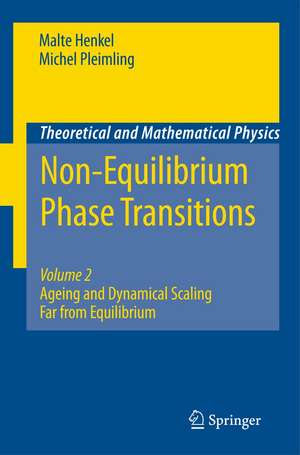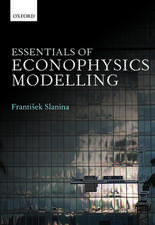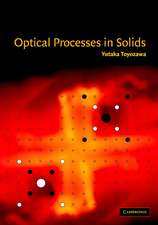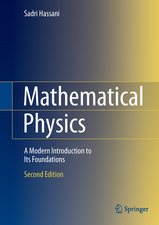Non-Equilibrium Phase Transitions: Volume 2: Ageing and Dynamical Scaling Far from Equilibrium: Theoretical and Mathematical Physics
Autor Malte Henkel, Michel Pleimlingen Limba Engleză Paperback – 20 noi 2014
| Toate formatele și edițiile | Preț | Express |
|---|---|---|
| Paperback (1) | 653.65 lei 6-8 săpt. | |
| SPRINGER NETHERLANDS – 20 noi 2014 | 653.65 lei 6-8 săpt. | |
| Hardback (1) | 663.79 lei 6-8 săpt. | |
| SPRINGER NETHERLANDS – 12 iul 2010 | 663.79 lei 6-8 săpt. |
Din seria Theoretical and Mathematical Physics
- 20%
 Preț: 697.22 lei
Preț: 697.22 lei - 18%
 Preț: 744.84 lei
Preț: 744.84 lei - 20%
 Preț: 699.50 lei
Preț: 699.50 lei -
 Preț: 396.82 lei
Preț: 396.82 lei - 15%
 Preț: 721.06 lei
Preț: 721.06 lei - 18%
 Preț: 1120.68 lei
Preț: 1120.68 lei -
 Preț: 398.35 lei
Preț: 398.35 lei - 15%
 Preț: 643.65 lei
Preț: 643.65 lei - 15%
 Preț: 508.60 lei
Preț: 508.60 lei - 20%
 Preț: 652.54 lei
Preț: 652.54 lei - 15%
 Preț: 646.75 lei
Preț: 646.75 lei - 15%
 Preț: 654.12 lei
Preț: 654.12 lei - 15%
 Preț: 649.87 lei
Preț: 649.87 lei -
 Preț: 396.24 lei
Preț: 396.24 lei - 15%
 Preț: 653.14 lei
Preț: 653.14 lei - 18%
 Preț: 960.78 lei
Preț: 960.78 lei - 15%
 Preț: 529.92 lei
Preț: 529.92 lei - 18%
 Preț: 1127.78 lei
Preț: 1127.78 lei - 18%
 Preț: 1548.71 lei
Preț: 1548.71 lei - 15%
 Preț: 551.53 lei
Preț: 551.53 lei - 18%
 Preț: 1002.75 lei
Preț: 1002.75 lei -
 Preț: 396.02 lei
Preț: 396.02 lei - 15%
 Preț: 648.89 lei
Preț: 648.89 lei - 18%
 Preț: 783.35 lei
Preț: 783.35 lei - 18%
 Preț: 973.38 lei
Preț: 973.38 lei - 18%
 Preț: 907.90 lei
Preț: 907.90 lei - 15%
 Preț: 655.78 lei
Preț: 655.78 lei - 18%
 Preț: 1118.93 lei
Preț: 1118.93 lei -
 Preț: 390.25 lei
Preț: 390.25 lei - 15%
 Preț: 663.79 lei
Preț: 663.79 lei - 15%
 Preț: 653.79 lei
Preț: 653.79 lei - 15%
 Preț: 645.28 lei
Preț: 645.28 lei - 15%
 Preț: 604.23 lei
Preț: 604.23 lei - 15%
 Preț: 639.25 lei
Preț: 639.25 lei - 15%
 Preț: 590.81 lei
Preț: 590.81 lei -
 Preț: 395.25 lei
Preț: 395.25 lei - 15%
 Preț: 589.33 lei
Preț: 589.33 lei - 19%
 Preț: 543.19 lei
Preț: 543.19 lei - 15%
 Preț: 594.24 lei
Preț: 594.24 lei - 18%
 Preț: 911.17 lei
Preț: 911.17 lei - 18%
 Preț: 957.75 lei
Preț: 957.75 lei -
 Preț: 409.13 lei
Preț: 409.13 lei - 15%
 Preț: 532.23 lei
Preț: 532.23 lei
Preț: 653.65 lei
Preț vechi: 769.00 lei
-15% Nou
Puncte Express: 980
Preț estimativ în valută:
125.08€ • 133.75$ • 104.29£
125.08€ • 133.75$ • 104.29£
Carte tipărită la comandă
Livrare economică 18 aprilie-02 mai
Preluare comenzi: 021 569.72.76
Specificații
ISBN-13: 9789401783729
ISBN-10: 9401783721
Pagini: 568
Ilustrații: XXI, 544 p.
Dimensiuni: 155 x 235 x 30 mm
Greutate: 0.79 kg
Ediția:2010
Editura: SPRINGER NETHERLANDS
Colecția Springer
Seria Theoretical and Mathematical Physics
Locul publicării:Dordrecht, Netherlands
ISBN-10: 9401783721
Pagini: 568
Ilustrații: XXI, 544 p.
Dimensiuni: 155 x 235 x 30 mm
Greutate: 0.79 kg
Ediția:2010
Editura: SPRINGER NETHERLANDS
Colecția Springer
Seria Theoretical and Mathematical Physics
Locul publicării:Dordrecht, Netherlands
Public țintă
ResearchCuprins
1. Ageing phenomena; 2. Exactly solvable models; 3. Simple ageing: an overview; 4. Local scale-invariance I: z = 2; 5. Local scale invariance II: z ≠ 2; 6. Lifshitz Points: Strongly Anisotropic Equilibrium Critical Points. Appendices: A. Equilibrium Models, D. Langevin Equations and Path Integrals, I. Cluster Algorithms: Competing Interactions. J. Fractional Derivatives. K. Conformally Invariant Interacting Fields. L. Lie Groups and Lie Algebras: a Reminder. M. On the Central Limit Theorem. Q. Lexique/Lexicon. Solutions. Frequently Used Symbols. Abbreviations. References. List of Tables. List of Figures. Index
Recenzii
From the reviews:
“This book is the second of a two-volume work on non-equilibrium phase transitions … . a well written and valuable introduction to these problems, for mathematicians as well as for physicists. … The book finishes with several appendices, where the reader can be reminded of useful physical and mathematical results … a large section where the almost one hundred problems proposed throughout the book are fully worked out, and a huge and very useful reference list of more than seven hundred fifty items.” (Fernando Pestana da Costa, Mathematical Reviews, Issue 2011 j)
“This book is the second of a two-volume work on non-equilibrium phase transitions … . a well written and valuable introduction to these problems, for mathematicians as well as for physicists. … The book finishes with several appendices, where the reader can be reminded of useful physical and mathematical results … a large section where the almost one hundred problems proposed throughout the book are fully worked out, and a huge and very useful reference list of more than seven hundred fifty items.” (Fernando Pestana da Costa, Mathematical Reviews, Issue 2011 j)
Notă biografică
Malte Henkel, born in 1960, received his Master's degree from the University of Bonn in 1984, and his PhD in 1987, when he also won the annual prize of the Minerva Foundation. From that year onward he has been a long-term visitor in many institutes, including the ITP at Santa Barbara, USA, the SPhT at Saclay, France, and the universities of Oxford, UK, Vienna, Austria, Padova, Italy, and Lisbon, Portugal. In 1995 he was appointed a professor at the University of Nancy I. His current research encompasses equilibrium and non-equilibrium phase transitions, using field-theoretical and numerical methods in general. In particular, his current focus is on dynamical scaling behaviour realised in ageing phenomena far from equilibrium. He has published well over a hundred articles and three monographs, one of which is Volume I of this set.
Textul de pe ultima copertă
This book is Volume 2 of a two-volume set describing two main classes of non-equilibrium phase-transitions. This volume covers dynamical scaling in far-from-equilibrium relaxation behaviour and ageing. Motivated initially by experimental results, dynamical scaling has now been recognised as a cornerstone in the modern understanding of far from equilibrium relaxation. Dynamical scaling is systematically introduced, starting from coarsening phenomena, and existing analytical results and numerical estimates of universal non-equilibrium exponents and scaling functions are reviewed in detail. Ageing phenomena in glasses, as well as in simple magnets, are paradigmatic examples of non-equilibrium dynamical scaling, but may also be found in irreversible systems of chemical reactions. Recent theoretical work sought to understand if dynamical scaling may be just a part of a larger symmetry, called local scale-invariance. Initially, this was motivated by certain analogies with the conformal invariance of equilibrium phase transitions; this work has recently reached a degree of completion and the research is presented, systematically and in detail, in book form for the first time. Numerous worked-out exercises are included. Quite similar ideas apply to the phase transitions of equilibrium systems with competing interactions and interesting physical realisations, for example in Lifshitz points.
Caracteristici
Focusses on simulation methods, scaling arguments and new methods using dynamical symmetries Reviews in detail existing non-perturbative quantitative results on non-equilibrium phase transitions
























